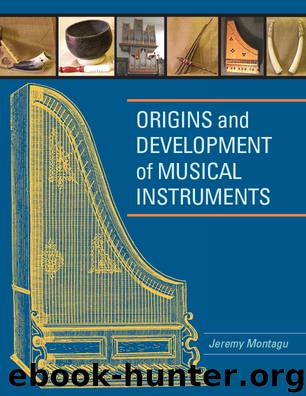Origins and Development of Musical Instruments by Montagu Jeremy;

Author:Montagu, Jeremy;
Language: eng
Format: epub
ISBN: 717055
Publisher: Scarecrow Press
We have referred above to symmetric and asymmetric lyres. On a symmetric lyre, each of the two arms extends the same distance above the body of the lyre and the two, if extended to a vertex below the body, would form two sides of an isosceles triangle. Thus all the strings were the same length and their pitch could differ only by varying tension (if carried to extreme that could deform the instrument) or mass. One of the problems of gut strings is that as the mass (in this context, inevitably controlled by the thickness) increases, the flexibility and thus the response of the string decreases. One way of avoiding this was by using what has become known as “high-twist gut.”21 Thus Homer’s use of the phrase “welltwisted” makes one wonder whether this was already known at so early a period in European musical history.
With the asymmetric lyre, on the other hand, the arm farther from the player is longer than the nearer one. As a result, the strings are unequal in length, and their pitch could be differentiated in this way, either solely or in combination with the other two factors, mass and tension, depending on the proportions of the instrument.
So far as we know, the modern idea of a tuning peg, a piece of wood with the string twined round it that would pierce the yoke and that could be turned to wind the string more or less, and so to tighten or slacken it, was unknown in antiquity. On the Sumerian lyres we have already met and the larger Ethiopian lyre yet to come, each string was wound around both the yoke and a small wooden bar that could then be used as a lever to help wind it further for tuning. An alternative method was to twine the string around a strip of animal skin and then to wind that around the bar of the yoke; this grips the yoke sufficiently to hold the tension, but can be turned to raise or lower the pitch for tuning. Both these methods can be seen on pots and other Greek illustrations, and both seem to be described in texts, although a problem is that the general word kollopes is used indiscriminantly for both.
The final problem in this area is with the larger lyre, the kithara, whose yoke has a round knob at each end. Was this turned to tighten or slacken all the strings simultaneously and thus transpose the pitch up or down a tone or so? Anyone who has tried to use such a method on any string instrument will know that it does not work—some strings stretch more or less than others. On the other hand, for a quick retuning, with one or two strings then touched up as necessary, it might be useful. Much ink has been spilled over the small elements within the curves of the arms of the kithara—are they some form of mechanism or not, and if so, for what purpose?
Download
This site does not store any files on its server. We only index and link to content provided by other sites. Please contact the content providers to delete copyright contents if any and email us, we'll remove relevant links or contents immediately.
The Goal (Off-Campus #4) by Elle Kennedy(13210)
Kathy Andrews Collection by Kathy Andrews(11342)
Diary of a Player by Brad Paisley(7272)
What Does This Button Do? by Bruce Dickinson(5937)
Assassin’s Fate by Robin Hobb(5867)
Big Little Lies by Liane Moriarty(5526)
Altered Sensations by David Pantalony(4872)
Pale Blue Dot by Carl Sagan(4631)
Sticky Fingers by Joe Hagan(3916)
The Death of the Heart by Elizabeth Bowen(3345)
The Heroin Diaries by Nikki Sixx(3327)
Beneath These Shadows by Meghan March(3156)
Confessions of a Video Vixen by Karrine Steffans(3106)
The Help by Kathryn Stockett(3023)
How Music Works by David Byrne(2969)
Jam by Jam (epub)(2882)
Harry Potter 4 - Harry Potter and The Goblet of Fire by J.K.Rowling(2818)
Strange Fascination: David Bowie: The Definitive Story by David Buckley(2703)
Petty: The Biography by Warren Zanes(2578)
